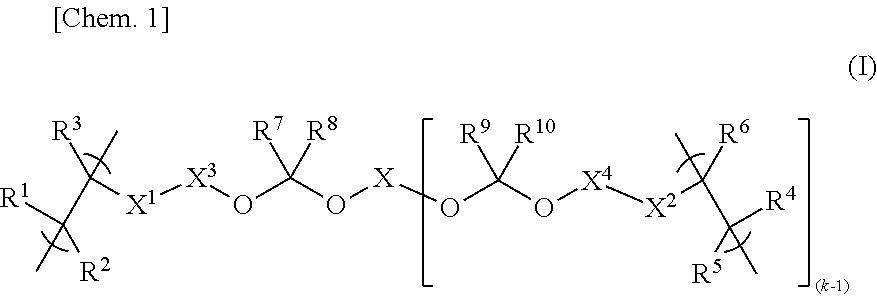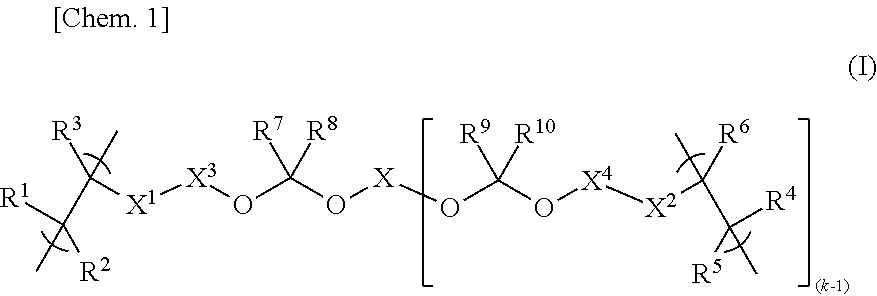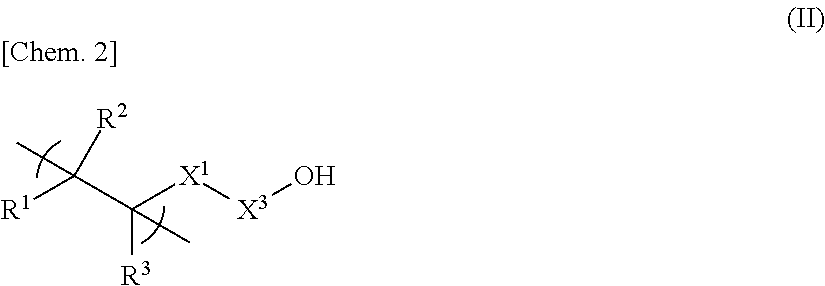Polymer for lithographic purposes and method for producing same
a technology of lithographic and polymer, applied in the direction of optics, basic electric elements, electric devices, etc., can solve the problems of insufficient cross-linking reaction efficiency of repulsing compound (polymer), low capacity of manufactured semiconductor devices, and low molecular weight of compound (polymer), so as to achieve high-precision operation and fine and sharp patterning
- Summary
- Abstract
- Description
- Claims
- Application Information
AI Technical Summary
Benefits of technology
Problems solved by technology
Method used
Image
Examples
referential example 1
Synthesis of 2,6-Naphthalenediol Divinyl Ether
[0104]To a solution of a mixture of di-μ-chlorobis(1,5-cyclooctadiene)diiridium(I) [Ir(cod)Cl]2 (2.1 g, 3.1 mmol) and sodium carbonate (26.2 g, 312.2 mmol) in toluene (250 g) were added 2,6-dihydroxynaphthalene (25 g, 156.1 mmol) and vinyl propionate (62.5 g, 624.3 mmol), followed by stirring in an argon atmosphere at 110° C. for 4 hours. The reaction mixture was analyzed by gas chromatography to find that 2,6-bis(vinyloxy)naphthalene was formed in a yield of 55%.
[Spectral Data of 2,6-bis(vinyloxy)naphthalene]
[0105]1H-NMR (CDCl3) δ: 4.50 (2H, d), 4.81 (2H, d), 6.75 (2H, dd), 7.22 (2H, d), 7.30 (2H, s), 7.71 (2H, d)
referential example 2
Synthesis of 2,6-Naphthalenedimethylol Divinyl Ether
[0106]To a solution of a mixture of di-μ-chlorobis(1,5-cyclooctadiene)diiridium(I) [Ir (cod)Cl]2 (0.86 g, 1.3 mmol) and sodium carbonate (10.7 g, 127.5 mmol) in toluene (100 g) were added 2,6-naphthalenedimethanol (12.0 g, 63.8 mmol) and vinyl propionate (25.5 g, 255.0 mmol), followed by stirring in an argon atmosphere at 110° C. for 6 hours. The reaction mixture was analyzed by gas chromatography to find that 2,6-bis(vinyloxymethyl)naphthalene was formed in a yield of 40%.
[Spectral Data of 2,6-bis(vinyloxymethyl)naphthalene]
[0107]1H-NMR (CDCl3) δ: 4.11 (2H, d), 4.36 (2H, d), 4.92 (4H, s), 6.61 (2H, dd), 7.47 (2H, d), 7.81 (2H, s), 7.84 (2H, d)
synthetic example 1
Synthesis of Polymeric Compound of Following Structure
[0108]
[0109]In a nitrogen atmosphere, 128.9 g of propylene glycol monomethyl ether acetate (PGMEA) and 55.3 g of propylene glycol monomethyl ether (PGME) were placed in a round-bottom flask equipped with a reflux condenser, a stirring bar, a three-way stopcock, and a thermometer; and, while keeping the temperature to 90° C. and stirring, a solution mixture was added dropwise thereto over 5 hours, followed by further stirring at the same temperature (90° C.) for 2 hours. The solution mixture contained 26.5 g (127.3 mmol) of 5-acryloyloxy-3-oxatricyclo[4.2.1.04,8]nonan-2-one, 6.0 g (25.4 mmol) of 1-hydroxy-5-methacryloyloxyadamantane, 13.3 g (50.7 mmol) of 1-(1-methacryloyloxy-1-methylethyl)adamantane, 4.4 g (51.1 mmol) of methacrylic acid, 4.02 g of dimethyl 2,2′-azobis(isobutyrate)dimethyl (supplied by Wako Pure Chemical Industries Ltd. under the trade name “V-601”), 69.4 g of PGMEA, and 29.8 g of PGME. After being cooled, the po...
PUM
| Property | Measurement | Unit |
|---|---|---|
| Wavelength | aaaaa | aaaaa |
| Molality | aaaaa | aaaaa |
| Surface roughness | aaaaa | aaaaa |
Abstract
Description
Claims
Application Information
 Login to View More
Login to View More - R&D
- Intellectual Property
- Life Sciences
- Materials
- Tech Scout
- Unparalleled Data Quality
- Higher Quality Content
- 60% Fewer Hallucinations
Browse by: Latest US Patents, China's latest patents, Technical Efficacy Thesaurus, Application Domain, Technology Topic, Popular Technical Reports.
© 2025 PatSnap. All rights reserved.Legal|Privacy policy|Modern Slavery Act Transparency Statement|Sitemap|About US| Contact US: help@patsnap.com



